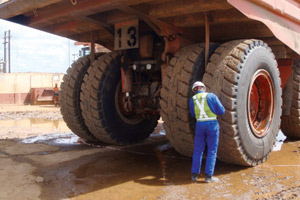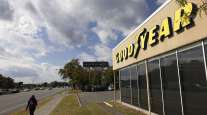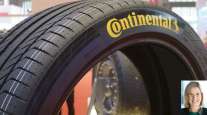Traction Is Most Important Characteristic For Off-Road Tires, Fleet Executives Say

This story appears in the March 3 print edition of Transport Topics.
Editor’s note: Also see two sidebars to this story, ‘Vocational Tire Sales Depend on Economy,’ and ‘Dealing With Tire Inflation Problems’.
When New Orleans-based electricity provider Entergy Corp. buys tires for its fleet — which handles a lot of off-road work — durability, fuel economy and cost take a back seat to what the company says is its most important need.
“We go with traction,” fleet manager Glenn Guillory said, explaining that the utility’s power lines typically aren’t “down the middle of a concrete or asphalt street.”
Because the vehicles — which include about 1,100 bucket trucks and 2,400 pickups, vans and cars — travel on-road and off, Entergy uses the most aggressive radial tire it can find for most rear-axle applications. And in some applications, it retreads the original worn-out tire with a more aggressive tread.
“When the lights are out, the customers sure don’t want to see us towing trucks around with wreckers trying to get them in and out,” said Jim LaBudde, Entergy’s superintendent for fleet assets.
However, there are trade-offs between traction and longevity.
“A tire is a series of compromises,” said Gary Enterline, product category manager for Michelin Americas Truck Tires. For example, tires with a higher void ratio — the void being the space where there is no tread rubber — can offer better traction.
But that extra space means less surface area contacts the road, and the tire’s lugs wear as they strike and then leave the pavement, he explained.
Curtis Decker, manager of product development for Continental Tires’ North American commercial-vehicle market, said the company helps fleets strike a balance among performance, durability and fuel economy. He also said some fleets err too aggressively on the side of traction.
For an application such as logging, traction is paramount if a truck gets stuck “in the soup,” he said, adding that it can be difficult and expensive to extricate the vehicle. However, other applications that involve driving on gravel require a less aggressive tread, so tires don’t wear as much or experience early catastrophic failure.
“Define what your tire will be ‘asked’ to do,” said Brian Buckham, Goodyear Commercial Tire Systems marketing manager. That definition should include “load ranges that the truck will haul, its percentage of on-road travel, the types of roads it will drive on and the level of traction that your tire is required to provide.”
He added, “The most common mistake we see is misapplication. You want to make sure you get it right, even before you purchase the tires.”
Fuel economy is not as important for completely off-road applications, Decker said, adding that while Continental will help fleets improve upon it, a lot depends on driver behavior and the application’s environment.
“When you go off-road [after] you’ve spent the money for rolling-resistant tires, oftentimes you don’t feel [the tire’s] benefit,” he said. “Even if [the rolling-resistance benefit is] there, it has been [masked] to a point where it’s difficult for the fleet to recognize that it happens.”
And Roger Best, original equipment manager for Bridgestone Commercial Solutions Group, said, “If you can afford to run the equipment, you can afford the fuel.”
Still, manufacturers say they are learning to balance traction, fuel economy and durability.
Buckham said Goodyear “has been able to make improvements in [any] two of the three performance categories with little or no sacrifices in the third.” Rick Phillips, Yokohama senior director for commercial and off-road tire sales, added, “As technology improves, we are actually able to enhance one area of a tire without greatly sacrificing other areas.”
Wide-base tires also are being used for off-road work. Guillory said. Entergy has used single wide tires on rear axles with some success.
And Enterline said Michelin offers wide-base tires for on-road/off-road applications. He said the X One XZY 3 can save about 400 pounds per dual axle with aluminum wheels.
Another challenge is many applications involve on-road and off-road use, where tires must withstand highway heat and the off-road environment. Aaron Murphy, vice president of China Manufacturers Alliance, which makes Double Coin tires, said today’s manufacturers are managing that balance better.
“In the past, many manufacturers used a single model or pattern of tire for most on/off-highway applications . . . a ‘catchall’ solution,” he said. “A tire may have done well off the road, but it would work poorly on the highway.
“Today’s on/off-highway tires use tread compounds that meet the rigorous pull/tension requirements to enhance traction and prevent cut and chip damage while the vehicle is off road,” he said, “but also perform with on-road expectations, including even wear and lower noise.”
But in some ways, the marketplace is making it harder to balance on-road and off-road use.
Continental’s Decker said consolidation between construction companies and aggregate haulers is resulting in larger distribution centers located farther from construction sites than previously. As a result, trucks are hauling construction materials 60 to 80 miles at highway speeds. Tire designs that once anticipated a 70-30 split in favor of off-road driving now often require the opposite.
That means manufacturers must try different approaches. Instead of using more rubber, they must incorporate different types of reinforcements, fillers and adhesion agents. Those come at a cost.
“It has to be an elegant design. Brute force doesn’t really work for tires,” Decker said.
That elegance includes new processes, compounds and structures for the casing design and belt packages.
Bridgestone’s Best said tires can contain up to 30 rubber components, including combinations of natural and synthetic rubbers. Natural rubbers are better for traveling on highways because they are more heat-resistant. Synthetic rubbers are denser and more durable but also create more friction. Heat is an enemy because it damages not only the rubber but also the tire’s steel cables — like a coat hanger that breaks after it’s bent back and forth rapidly, Best said.
And while radial tires are the choice for on-road transportation and larger off-roaders, Kevin Rohlwing, senior vice president of training for the Tire Industry Association, said smaller bias-ply tires still enjoy a strong market presence. The primary reason: cost.
While radial tires last longer, a bias-ply tire may cost half as much. For a construction company whose vehicles don’t travel many miles on-road, that can be a deciding factor.
“You don’t measure [off-road tire] life in miles; you measure it in hours,” Rohlwing said.
Additionally, if a customer isn’t satisfied with the product on the shelf, tire-company executives said, users are not afraid to tell manufacturers that a particular application demands a unique design.
An example is utility company Pacific Gas & Electric Co., headquartered in San Francisco. For PG&E, even the slightest adjustment in tread or compound composition can make a huge difference in tire performance and longevity, said David Meisel, senior director of transportation and aviation services.
“The pattern of the tread and the depth of the tread is really what gives you your traction, particularly in off-road operations,” he said. “And depending on whether you’re in loose gravel or hard rock or normal pavement, that actually determines the life of the tire.”
The diverse terrain along PG&E’s hydroelectric generating facility — the largest in the nation, Meisel said — presents a variety of challenges for the fleet’s tires.
“It’s a dam network, and dams . . . start in the mountains and work their way down,” Meisel said. “Everywhere there is a dam, we have to go there [to] service it and maintain it.”
Eventually, he said, the terrain in these areas began taking a toll on the tires in PG&E’s fleet.
“Our vehicles were getting into areas where the dams were, which were typically rock — definitely not smooth,” Meisel said. “We’re climbing up the hills, and it was just tearing these tires apart, tearing chunks out of the tires.”
So Meisel, who tired of replacing tires every few months, asked Goodyear Tire & Rubber Co. to come up with a solution. Goodyear changed the compound to strengthen the tires’ resistance to the utility’s specific application.
“The compound change gave us the hardness of the tire,” Meisel said. “We could have gone all the way to the other end of the spectrum — an incredibly hard tire — but we wouldn’t have had the traction. They got us to the right spot in between.”
Dan Calabrese contributed to this report.




